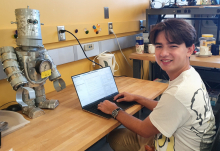
Major:
University:
Mentor(s):
Faculty Sponsor(s):
Faculty Sponsor's Department(s):
Project Title:
Project Description:
Trajectory optimization is a method for solving problems in control theory, given a set of constraints for motion across space. One of the biggest challenges in generating a solution via trajectory optimization is how to tune parameters and create an input guess for a multi-stage, path constrained system that will properly converge to a solution. Our goal is to simulate a model that calculates an optimal trajectory of a point mass between multiple obstacles, given we must minimize a performance cost function in either time or force. Prior attempts of similar problems have been non-modular systems with different measures of performance between only two points. These models, while helpful, do not provide generalized insight into tendencies of convergent, multi-stage solutions. We hypothesize that having a modular system can be immensely beneficial for generating input guesses and tuning parameters that will lead to a convergent solution of more complex, multi-stage systems. Such a model provides easier and more thorough insight into the nature of guesses that will lead to convergent solutions, and how minute perturbations can affect the overall nature and convergence of the solution. For example, we have observed that alterations of a singular parameter by a seemingly negligible amount can cause a currently converging solution and trajectory to diverge and fail to generate a solution. Furthermore, solutions tend towards non-feasibility when restricting path constraints closer to initial and final boundaries. Additionally, our model confirmed prior research that time optimization and addition of more constraints add substantial internal difficulty to the overall problem, and that a linear simplification of the problem with no path constraints is a consistent initial guess towards arriving at a final solution. Currently our model optimizes the trajectory between two arbitrary points avoiding obstacles, with the final velocity angle being constrained to a range of the angle to the next point. This can repeat iteratively for an arbitrary number of points and obstacles all continuing from the prior solutions final point. Future uses of this model could be with machine learning training or with using the solutions generated as simplified guesses for more complex systems.
